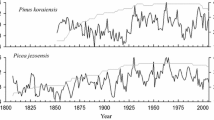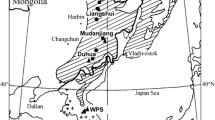Abstract
The southern part of northeast China has experienced a marked warming and drying climate. We provide dendrochronological evidence for atmospheric CO2 fertilization and the impacts of warming on Chinese pine (Pinus tabulaeformis) growth. The results of this study show that increased temperature has a negative effect on pine growth during a major part of the growing season and a weakly positive effects on growth during the remaining portion of the year. The monthly temperatures explain ca. 20 % of the total variance in the annual radial growth of Chinese pine from 1901 to 2009. An increase of approximately 3–5 °C is the maximum that Chinese pine can tolerate in this region with an annual rainfall of 500–700 mm. Our results suggest a that there is a proportional response to warming only up to a maximum of 1 °C warming, and indicate the complexitiesof succession in forest ecosystems in terms of adaptation and evolution in local pine populations under a rapid warming condition. In addition, increasing atmospheric CO2 concentrations have a positive effect on tree growth. This effect can be detected with conventional dendrochronological methods.





Similar content being viewed by others
References
Adam NR, Wall GW, Kimball BA, Idso BS, Webber AN (2004) Photosynthetic down-regulation over long-term CO2 enrichment in leaves of sour orange (Citrus aurantium) trees. New Phytol 163:341–347
Ahn J, Brook EJ (2008) Atmospheric CO2 and climate on millennial time scales during the last glacial period. Science 322:83–85
Barber VA, Juday GP, Finney BP (2000) Reduced growth of Alaskan white spruce in the twentieth century from temperature-induced drought stress. Nature 405:668–672
Briffa KR, Jones PD, Bartholin TS, Eckstein D, Schweingruber FH, Karlen W, Zetterberg P, Eronen M (1992) Fennoscandian summers from AD 500: temperature changes on short and long timescales. Clim Dyn 7:111–119
Bunn AG, Goetz SJ, Fiske GJ (2005) Observed and predicted responses of plant growth to climate across Canada. Geophys Res Lett 32, L16710. doi:10.1029/2005GL023646
Chen ZJ, Sun Y, He XY, Chen W, Shao XM, Zhang HY, Wang ZY, Liu XY (2008) Chinese pine tree ring width chronology and its relation to climate conditions in the Qianshan Mountains. Front For China 3(4):381–392
Cook ER (1985) A time-series analysis approach to tree-ring standardization. Ph.D. dissertation, University of Arizona. Tucson, USA
Cook ER, Holmes RL (1986) Users manual for program ARSTAN. In: Holmes RL, Adams RK, Fritts HC (eds) Tree-ring chronologies of Western North America: California, eastern Oregon and northern Great Basin. Chronology 6, University of Arizona, Tucson, pp 50–65
Esper J, Cook ER, Schweingruber FH (2002) Low-frequency signals in long tree-ring chronologies for reconstructing past temperature variability. Science 295:2250–2253
Frank D, Büntgen U, Esper J (2009) Comment on “Late 20th century growth acceleration in Greek firs (Abies cephalonica) from Cephalonica Island, Greece: a CO2 fertilization effect?”. Dendrochronologia 27:223–227
Fritts HC (1976) Tree rings and climate. Academic, London
Gedalof Z, Berg AA (2010) Tree ring evidence for limited direct CO2 fertilization of forests over the 20th century. Glob Biogeochem Cycles 24, GB3027. doi:10.1029/2009GB003699
He HS, Hao ZQ, Mladenoff DJ, Shao GF, Hu YM, Chang Y (2005) Simulating forest ecosystem response to climate warming incorporating spatial effects in north-eastern China. J Biogeogr 32:2043–2056
He XY, Chen ZJ, Chen W, Shao XM, He HS, Sun Y (2007) Solar activity, global surface air temperature anomaly and Pacific Decadal Oscillation recorded in urban tree rings. Ann For Sci 64:743–756
Holmes RL (1983) Computer-assisted quality control in tree-ring dating and measurement. Tree-Ring Bull 43:69–78
Idso SB (1999) The long-term response of trees to atmospheric CO2 enrichment. Glob Chang Biol 5:493–495
IPCC (2014) Climate Change 2014: Synthesis Report. IPCC Press release at http://www.ipcc.ch/
Jacoby GC, D’Arrigo RD (1997) Tree rings, carbon dioxide, and climatic change. PNAS 94:8350–8353
Koutavas A (2008) Late 20th century growth acceleration in greek firs (Abies cephalonica) from Cephalonia Island, Greece: a CO2 fertilization effect? Dendrochronologia 26:13–19
Kozlowski TT (1971) Growth and development of trees. Academic, New York, pp 315–320
Leng W, He HS, Bu R, Dai L, Hu Y, Wang X (2008) Predicting the distributions of suitable habitat for three larch species under climate warming in Northeastern China. For Ecol Manag 254:420–428
Liang EY, Eckstein D, Liu HY (2008) Climate-growth relationships of relict Pinus tabulaeformis at the northern limit of its natural distribution in northern China. J Veg Sci 19:393–406
Piao S, Ciais P, Friedlingstein P, Peylin P, Reichstein M, Luyssaert S, Margolis H, Fang JY, Barr A, Chen AP, Grelle A, Hollinger DY, Laurila T, Lindroth A, Richardson AD, Vesala T (2008) Net carbon dioxide losses of northern ecosystems in response to autumn warming. Nature 451:49–53
Rey A, Jarvis PG (1998) Long-term photosynthetic acclimation to increased atmospheric CO2 concentration in young birch (Betula pendula) trees. Tree Physiol 18:441–450
Saurer M, Cherubin P, Bonani G, Siegwolf R (2003) Tracing carbon uptake from a natural CO2 spring into tree rings: an isotope approach. Tree Physiol 23:997–1004
Sen PK (1968) Estimates of the regression coefficient based on Kendall’s tau. J Am Stat Assoc 63:1379–1389. doi:10.2307/2285891
Song Y, Linderholm HW, Chen D, Walther A (2010) Trends of the thermal growing season in China, 1951–2007. Int J Climatol 30:33–43
Stokes MA, Smiley TL (1968) An introduction to tree ring dating. University of Chicago Press, Chicago
Thornthwaite CW (1948) An approach toward a rational classification of climate. Geogr Rev 38:55–94
Tognetti R, Cherubini P, Innes J (2000) Comparative stem-growth rates of Mediterranean trees under background and naturally enhanced ambient CO2 concentrations. New Phytol 146:59–74
van Mantgem PJ, Stephenson NL, Byrne JC, Daniels LD, Franklin JF, Fulé PZ, Harmon ME, Larson AJ, Smith AM, Taylor AH, Veblen TT (2009) Widespread increase of tree mortality rates in the western United States. Science 323:521–524
Wagner F, Below R, DeKlerk P, Dilcher DL, Joosten H, Kurschner WM, Visscher H (1996) A natural experiment on plant acclimation: lifetime stomatal frequency response of an individual tree to annual atmospheric CO2 increase. PNAS 93:11705–11708
Warren JM, Norby RJ, Wullschleger SD (2011) Elevated CO2 enhances leaf senescence during extreme drought in a temperate forest. Tree Physiol 31:117–130
Way DA (2011) The bigger they are, the harder they fall: CO2 concentration and tree size affect drought tolerance. Tree Physiol 31:115–116
Wigley T, Briffa KR, Jones PD (1984) On the average value of correlated time series, with applications in dendroclimatology and hydrometeorology. J Clim Appl Meteorol 23:201–213
Wu ZY, Wu SG (1998) A proposal for a new floristic kingdom (realm)-the E. Asiatic kingdom, its delineation and characteristics. In: Zhang AL, Wu SG (eds) Floristic characteristics and diversity of East Asian plants. China Higher Education Press, Beijing, Springer-Verlag, Berlin, pp 3–42
Xiong KG, Feng GL, Huang JP, Chou JF (2011) Analogue-dynamical prediction of monsoon precipitation in Northeast China based on dynamic and optimal configuration of multiple predictors. Acta Meteorol Sin 25(3):316–326
Xu HC (1990) Pinus tabulaeformis. China Forestry Publishing House, Beijing (in Chinese)
Zimov SA, Davidov SP, Zimova GM, Dovidova AI, Chapin FS III, Chapin MC, Reynolds JF (1999) Contribution of disturbance to increasing seasonal amplitude of atmospheric CO2. Science 284:1973–1976
Acknowledgments
This work was funded by the National Natural Science Foundation of China Project 41271066, 31100327 and 41071035, the US National Science Foundation Project AGS-PRF: #1137729, and the Tianzhu-Shan Scholars Programme of SAU.
Author information
Authors and Affiliations
Corresponding author
Rights and permissions
About this article
Cite this article
Chen, Z., Zhang, X., He, X. et al. Response of radial growth to warming and CO2 enrichment in southern Northeast China: a case of Pinus tabulaeformis . Climatic Change 130, 559–571 (2015). https://doi.org/10.1007/s10584-015-1356-8
Received:
Accepted:
Published:
Issue Date:
DOI: https://doi.org/10.1007/s10584-015-1356-8




